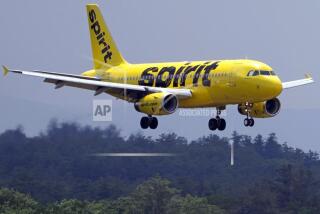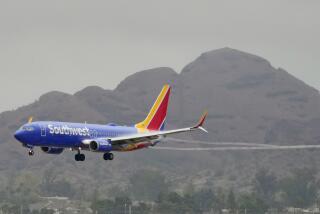Deadline Arrives for Investors to Submit Bids to Reorganize America West Airlines : Transportation: The carrier has struggled back to profitability, but its long-term prospects are still in doubt.
- Share via
When America West Airlines fell into bankruptcy 2 1/2 years ago, the Phoenix-based carrier that had become a major player in the Southwest was written off by many observers as yet another victim of a vicious industry slump.
But America West has been able to foil its critics by slashing costs, dumping unprofitable routes and ousting its top executives. It even generated a profit last year. The cleanup was enough to attract potential investors such as American Airlines and the Pritzker family of Hyatt Hotels fame.
Still, as today’s deadline arrives for potential investors to submit their bids to reorganize the carrier, skepticism remains about the carrier’s long-term future.
The stock plunged 84 cents to $2.375 on Nasdaq on Wednesday.
Not only would America West and its new investors have to deal with day-to-day survival in an especially perilous and cutthroat industry, but the carrier must grow in the shadow of powerful archrival Southwest Airlines.
“I think it’s a company that’s got a very tough road to go,” said David Hoppin, an airline consultant at Arlington, Va.-based MergeGlobal.
Executives of the airline have said that several potential bidders have expressed interest, but they have not said how many have submitted offers. The only publicly known offer is from Steinhardt Group, a New York investment firm that has proposed injecting $250 million into the airline in return for an 80% ownership stake.
America West and its 11,000 employees have traveled through turbulent times since the carrier filed for Chapter 11 Bankruptcy Court protection from creditors in June, 1991.
America West executives, who were not available to be interviewed, have turned back the clock on ambitious overseas and domestic expansion plans that weighed the airline down with debt and raised operating expenses. Gone are its costly 747 jumbo jets and international service to Japan.
The reorganization has also been marred by a messy power struggle between former President Michael Conway--one of the airline’s founders--and William Franke, who became America West’s chairman in 1992 after raising cash to keep it aloft. Conway was ousted late last year, but only after the feud led an investment group headed by the Pritzker family to drop out as potential owners.
Workers have also paid a heavy price to hold on to their jobs. Not only have they taken pay cuts, but the America West stock they purchased as a condition of employment will probably be worthless when the company completes its reorganization.
“Their employees were large losers in terms of the stock,” said David Ulmer, an airline consultant at Roberts & Associates in Hayward, Calif. “At some point, they need to start to (improve) employee morale and wage structure.”
But, say Ulmer and other industry observers, America West has gone farther in correcting its problems in Bankruptcy Court than larger rivals Continental or Trans World Airlines, both of which recently emerged from Chapter 11 protection.
“The expansionist vision that started them down the road to bankruptcy, that’s gone,” Ulmer said. “I think they have returned to the basics.”
The carrier’s most significant accomplishment since filing for bankruptcy is cutting its operating costs even below those of Southwest, whose low-cost philosophy allows it to undercharge competitors and still generate a profit.
But Southwest remains a formidable foe that has dogged America West. At its hub in Phoenix, America West has been waging a losing battle against Southwest’s expansion into the Arizona city. When America West established a hub in Columbus, Ohio, Southwest soon followed with service there.
The competition with Southwest and the emergence of other low-cost carriers such as Reno Air will make America West’s ability to boost business even more difficult, Hoppin said.
“The history of the industry is full of low-cost airlines that went out of business,” he said. “People Express was a low-cost carrier. Low costs don’t save the day unless you get enough business to make money.”
More to Read
Inside the business of entertainment
The Wide Shot brings you news, analysis and insights on everything from streaming wars to production — and what it all means for the future.
You may occasionally receive promotional content from the Los Angeles Times.










